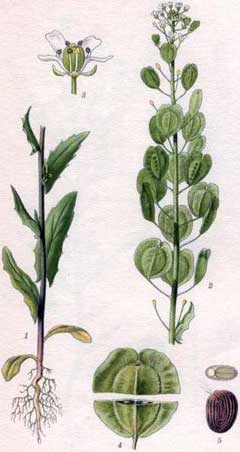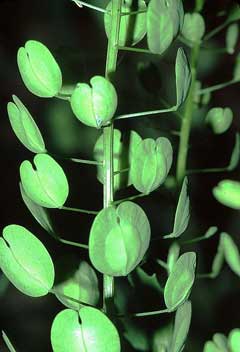 |
|
http://commons.wikimedia.org/wiki/File:Thlaspi_arvense_penning%C3%B6rt.jpg |
 |
| http://commons.wikimedia.org/wiki/User:Fornax |
Translate this page:
Summary
Physical Characteristics

 thlaspi arvense is a ANNUAL growing to 0.6 m (2ft).
thlaspi arvense is a ANNUAL growing to 0.6 m (2ft).
See above for USDA hardiness. It is hardy to UK zone 6 and is not frost tender. It is in flower from May to July, and the seeds ripen from July to September. The species is hermaphrodite (has both male and female organs) and is pollinated by Bees, flies. The plant is self-fertile.
Suitable for: light (sandy), medium (loamy) and heavy (clay) soils. Suitable pH: mildly acid, neutral and basic (mildly alkaline) soils. It cannot grow in the shade. It prefers moist soil.
UK Hardiness Map
US Hardiness Map
Synonyms
Plant Habitats
Cultivated Beds;
Edible Uses
Edible Parts: Leaves Oil Seed
Edible Uses: Condiment Oil
Young leaves - raw or cooked[2, 5, 52, 62, 185]. They should always be harvested before the plant comes into flower or they will be very bitter[9]. Even the young leaves have a somewhat bitter flavour and aroma, and are not to everyone's taste[9, 85]. They can be added in small quantities to salads and other foods[9, 183]. They can also be cooked in soups or used as a potherb, they taste somewhat like mustard but with a hint of onion[183]. For a leaf, it is very rich in protein[218]. The seed is ground into a powder and used as a mustard substitute[105, 183]. The seed can be sprouted and added to salads[183].
References More on Edible Uses
| Composition
|
| Figures in grams (g) or miligrams (mg) per 100g of food.
|
|
|
Leaves (Dry weight)
|
|
- 0 Calories per 100g
- Water : 0%
- Protein: 54.2g; Fat: 0g; Carbohydrate: 33.1g; Fibre: 0g; Ash: 0g;
- Minerals - Calcium: 0mg; Phosphorus: 0mg; Iron: 0mg; Magnesium: 0mg; Sodium: 0mg; Potassium: 0mg; Zinc: 0mg;
- Vitamins - A: 0mg; Thiamine (B1): 0mg; Riboflavin (B2): 0mg; Niacin: 0mg; B6: 0mg; C: 1900mg;
- Reference: [ 218]
- Notes:
|
|
Medicinal Uses
Plants For A Future can not take any responsibility for any adverse effects from the use of plants. Always seek advice from a professional before using a plant medicinally.
Antibacterial Antidote Antiinflammatory Antirheumatic Blood tonic Diaphoretic Diuretic Expectorant
Febrifuge Hepatic Ophthalmic Tonic
Antirheumatic, diuretic[46, 61]. The seed is a tonic[218]. Both the seed and the young shoots are said to be good for the eyes[218]. The seeds are used in Tibetan medicine and are considered to have an acrid taste and a cooling potency[241]. They are anti-inflammatory and febrifuge, being used in the treatment of pus in the lungs, renal inflammation, appendicitis, seminal and vaginal discharges[241]. The entire plant is antidote, anti-inflammatory, blood tonic, depurative, diaphoretic, expectorant, febrifuge and hepatic[176, 218]. It is used in the treatment of carbuncles, acute appendicitis, intestinal abscess, post-partum pain, dysmenorrhoea and endometriosis[176]. Use with caution since large doses can cause a decrease in white blood cells, nausea and dizziness[176]. The plant has a broad antibacterial activity[218], effective against the growth of Staphylococci and streptococci[176].
References More on Medicinal Uses
The Bookshop: Edible Plant Books
Our Latest books on Perennial Plants For Food Forests and Permaculture Gardens in paperback or digital formats.

Edible Tropical Plants
Food Forest Plants for Hotter Conditions: 250+ Plants For Tropical Food Forests & Permaculture Gardens.
More

Edible Temperate Plants
Plants for Your Food Forest: 500 Plants for Temperate Food Forests & Permaculture Gardens.
More

More Books
PFAF have eight books available in paperback and digital formats. Browse the shop for more information.
Shop Now
Other Uses
Oil
The seed contains 20 - 30% of a semi-drying oil, it is used for lighting[74].
Special Uses
References More on Other Uses
Cultivation details
An easily grown plant, it succeeds in most soils. Dislikes shade.
References Carbon Farming Information and Carbon Sequestration Information
Temperature Converter
Type a value in the Celsius field to convert the value to Fahrenheit:
Fahrenheit:
The PFAF Bookshop
Plants For A Future have a number of books available in paperback and digital form. Book titles include Edible Plants, Edible Perennials, Edible Trees,Edible Shrubs, Woodland Gardening, and Temperate Food Forest Plants. Our new book is Food Forest Plants For Hotter Conditions (Tropical and Sub-Tropical).
Shop Now
Plant Propagation
Seed - sow in situ in March or April.
Other Names
If available other names are mentioned here
Native Range
TEMPERATE ASIA: Afghanistan, Iran, Turkey, Armenia, Azerbaijan, Georgia, Russian Federation-Western Siberia (Western Siberia), Russian Federation-Eastern Siberia (Eastern Siberia), Kazakhstan, Kyrgyzstan, Tajikistan, Turkmenistan, Uzbekistan, Mongolia (north), Russian Federation-Far East (Far East (south)), China, Korea, Japan (Hokkaidô, Honshu, Kyushu, Ryukyu Islands, Shikoku) TROPICAL ASIA: Bhutan, India, Nepal, Pakistan (north) EUROPE: Denmark, Finland, United Kingdom, Ireland, Norway, Sweden, Austria, Belgium, Switzerland, Czech Republic, Germany, Hungary, Netherlands, Poland, Slovakia, Russian Federation (European part), Belarus, Estonia, Lithuania, Latvia, Moldova, Ukraine (incl. Krym), Albania, Bulgaria, Bosnia and Herzegovina, Greece (north), Croatia, Italy, North Macedonia, Montenegro, Romania, Serbia, Slovenia, Spain, France
Weed Potential
Right plant wrong place. We are currently updating this section.
Please note that a plant may be invasive in one area but may not in your area so it's worth checking.
Conservation Status
IUCN Red List of Threatened Plants Status :

Growth: S = slow M = medium F = fast. Soil: L = light (sandy) M = medium H = heavy (clay). pH: A = acid N = neutral B = basic (alkaline). Shade: F = full shade S = semi-shade N = no shade. Moisture: D = dry M = Moist We = wet Wa = water.
Now available:
Food Forest Plants for Mediterranean Conditions
350+ Perennial Plants For Mediterranean and Drier Food Forests and Permaculture Gardens.
[Paperback and eBook]
This is the third in Plants For A Future's series of plant guides for food forests tailored to
specific climate zones. Following volumes on temperate and tropical ecosystems, this book focuses
on species suited to Mediterranean conditions—regions with hot, dry summers and cool, wet winters,
often facing the added challenge of climate change.
Read More
Expert comment
Author
L.
Botanical References
17200
Links / References
For a list of references used on this page please go here
Readers comment
© 2010, Plants For A Future. Plants For A Future is a charitable company limited by guarantee, registered in England and Wales. Charity No. 1057719, Company No. 3204567.